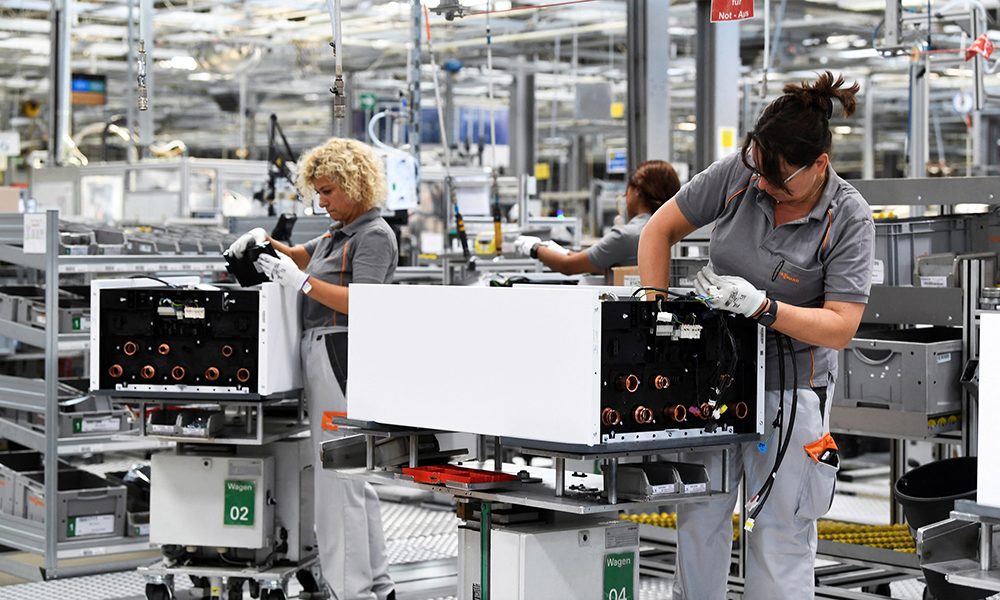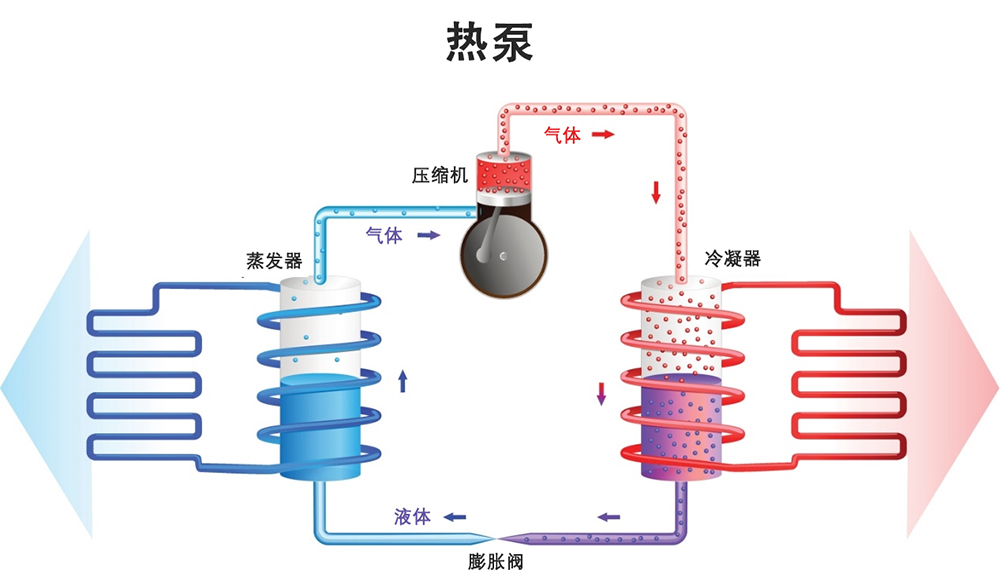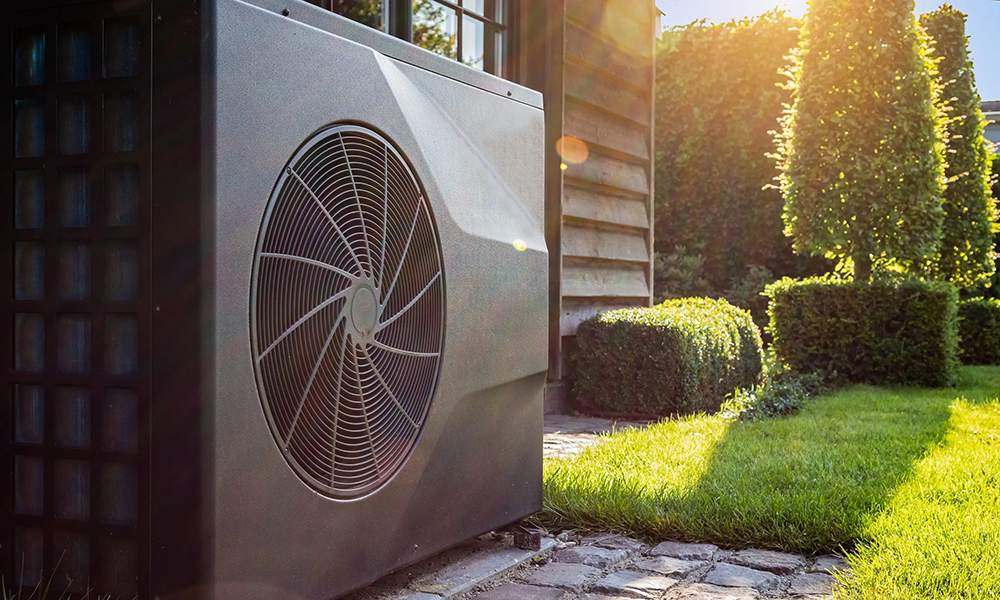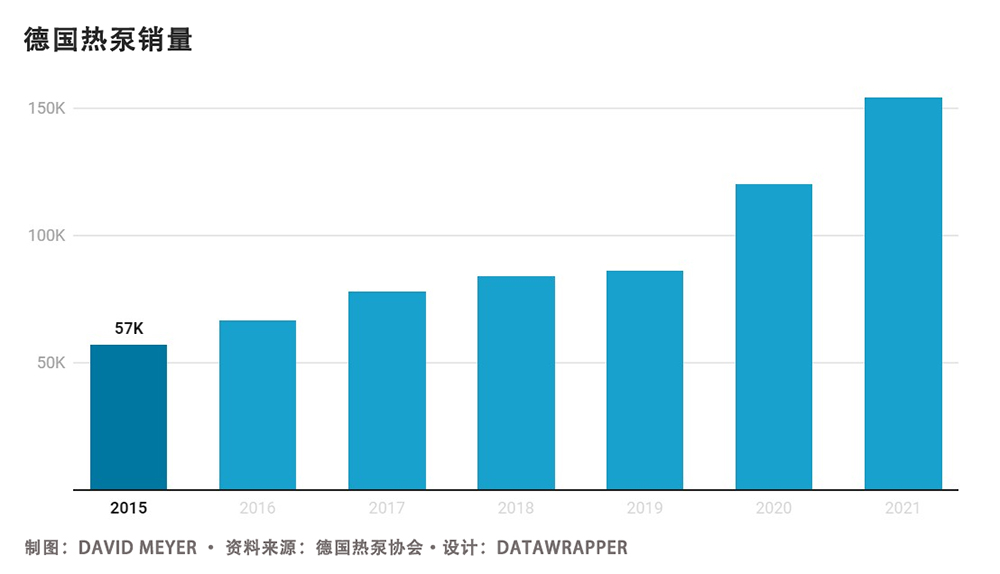
普遍的能源危機(jī)?通脹高企?如果說(shuō)歷史有規(guī)律,那么2022年就讓人回想起20世紀(jì)70年代。當(dāng)時(shí),1973年的中東戰(zhàn)爭(zhēng)和1979年的伊朗革命這兩場(chǎng)災(zāi)難,導(dǎo)致中東地區(qū)的石油出口嚴(yán)重中斷,隨后引發(fā)的能源危機(jī)令西方經(jīng)濟(jì)陷入衰退,讓許多人警醒尋找替代能源的必要性。
這場(chǎng)危機(jī)讓19世紀(jì)中葉問世的一種技術(shù)開始走紅,它就是熱泵,即將地面、水和空氣中的熱量輸送到建筑當(dāng)中。公司競(jìng)相投資這種笨重的、讓人難以形容的方盒子,但隨著危機(jī)結(jié)束,化石能源價(jià)格回落,這種簡(jiǎn)陋的熱泵基本被淘汰。
如今,俄羅斯的天然氣戰(zhàn)略迫使歐洲關(guān)閉工廠,面對(duì)寒冬陷入絕望,這時(shí)候人們又想起了熱泵。而這一次,日益嚴(yán)重的氣候危機(jī)需要快速采用可再生能源,這意味著熱泵可能不會(huì)退出歷史舞臺(tái)。
德國(guó)供暖和制冷巨頭菲斯曼集團(tuán)(Viessmann)的首席執(zhí)行官馬克思·菲斯曼說(shuō):“我們有解決方案。[熱泵]實(shí)際上比人們想象的更先進(jìn),而且現(xiàn)在它們需要擴(kuò)大規(guī)模。”
450%的效率
熱泵系統(tǒng)由建筑外部和內(nèi)部的連接設(shè)備組成,造型上或許毫無(wú)吸引力:最常見的空氣源熱泵與大型空調(diào)機(jī)的外形類似,但它們非常高效。

雖然基于煤氣爐的供暖系統(tǒng)最高效率為95%,即每燃燒100個(gè)單位的能量可以釋放95個(gè)單位的能量,但現(xiàn)代熱泵的效率高達(dá)450%。在系統(tǒng)中投入1個(gè)單位的電能,通常至少能夠輸出4.5個(gè)單位的熱能。首先,系統(tǒng)釋放的熱量已經(jīng)存在于大氣當(dāng)中,這與化石能源產(chǎn)生的能量不同。
據(jù)國(guó)際能源署(International Energy Agency)2021年11月的報(bào)告顯示,美國(guó)接近一半新建多戶住宅和超過40%的新建單戶住宅,都安裝了熱泵,不難看出背后的原因。舊建筑也開始安裝熱泵,盡管這意味著需要在墻上開洞,還要重新進(jìn)行電氣連接,因此目前這種舊房改造依舊是相對(duì)較小的市場(chǎng)。熱泵的價(jià)格當(dāng)然高于污染更嚴(yán)重的同類產(chǎn)品,但它們的運(yùn)行成本低得多。根據(jù)房屋的尺寸,熱泵的售價(jià)可能達(dá)到數(shù)萬(wàn)美元。

熱泵還有額外的好處:大多數(shù)熱泵還可以作為制冷系統(tǒng)。與冰箱和空調(diào)一樣,熱泵使用名為制冷劑的液體輸送熱量,只是它們從外向內(nèi)輸送,而不是從內(nèi)向外輸送。大多數(shù)空氣源熱泵和水源熱泵都能夠進(jìn)行反向操作,將室內(nèi)溫度降低5攝氏度。在氣候更溫暖的地區(qū),熱泵當(dāng)然不能取代空調(diào),但在歐洲所處的溫帶,并不常用空調(diào),高溫卻變得日益普遍和極端,因此熱泵的制冷效果是一個(gè)重要的賣點(diǎn)。
這意味著熱泵會(huì)迎來(lái)大量投資。
熱泵投資
已經(jīng)有105年歷史的菲斯曼集團(tuán)最近宣布,未來(lái)三年將在熱泵和其他綠色產(chǎn)品領(lǐng)域投資10億美元。
菲斯曼是德國(guó)被稱為中小企業(yè)的中等家族企業(yè)的典型代表,這些中小企業(yè)是德國(guó)經(jīng)濟(jì)的支柱。德國(guó)正在緊急采取措施,應(yīng)對(duì)快速氣候變化和關(guān)系國(guó)家存亡的能源危機(jī)。馬克思是該家族企業(yè)的第四代掌門人,目前公司市值達(dá)到34億美元。菲斯曼在1979年推出了第一款熱泵,但隨著能源危機(jī)結(jié)束,這項(xiàng)技術(shù)便被封存。二十年前,該公司重啟熱泵業(yè)務(wù),去年在德國(guó)的市場(chǎng)份額達(dá)到約15%。
現(xiàn)在,菲斯曼需要維護(hù)其作為德國(guó)市場(chǎng)領(lǐng)導(dǎo)者之一的地位,因?yàn)槠涓?jìng)爭(zhēng)對(duì)手正在加大對(duì)熱泵技術(shù)的投入。
有98年歷史的供暖公司世創(chuàng)電能(Stiebel Eltron)在20世紀(jì)70年代進(jìn)軍熱泵業(yè)務(wù),并且從未放棄,盡管該技術(shù)成為公司的虧損大戶,直到最近才有所好轉(zhuǎn)。去年,為了滿足需求,公司熱泵產(chǎn)量增長(zhǎng)了60%。現(xiàn)在,世創(chuàng)電能成為歐洲前五大熱泵生產(chǎn)商之一,今年8月宣布未來(lái)五年將再投資6億美元用于熱泵生產(chǎn)和研發(fā)。
該公司是總經(jīng)理石富本(Kai Schiefelbein)表示:“盡管天然氣會(huì)產(chǎn)生大量二氧化碳,但人們還是會(huì)首選使用天然氣,這時(shí)候,這種更昂貴的設(shè)備就很難銷售,即使它的二氧化碳排放更低。目前的狀況是,由于氣候保護(hù)的原因,歐洲熱泵市場(chǎng)正在快速增長(zhǎng)。”
事實(shí)上,雖然烏克蘭危機(jī)導(dǎo)致今年熱泵需求激增,許多買家要等幾個(gè)月才能夠收到新熱泵,但從2019年以來(lái),德國(guó)的熱泵需求便已經(jīng)在大幅增長(zhǎng),當(dāng)時(shí)德國(guó)政府為了努力實(shí)現(xiàn)其氣候目標(biāo)增加了對(duì)熱泵的補(bǔ)貼。
在全世界,建筑供暖、制冷和供電占溫室氣體排放量的四分之一。據(jù)政府支持的氣候透明組織(Climate Transparency)統(tǒng)計(jì),2020年,德國(guó)人均建筑相關(guān)碳排放量比G20國(guó)家平均水平高56%,主要原因是建筑普遍使用天然氣和石油供暖。這導(dǎo)致供暖和交通運(yùn)輸,成為立法者關(guān)注的首要目標(biāo)。
隨著新補(bǔ)貼政策的實(shí)施,從2019年到2020年,德國(guó)熱泵銷量增長(zhǎng)了40%,2021年又增長(zhǎng)了28%,達(dá)到154,000臺(tái),其中有900,000臺(tái)在本土銷售。(據(jù)國(guó)際能源署統(tǒng)計(jì),2020年全球共安裝熱泵1.77億臺(tái),之前五年每年增長(zhǎng)約10%。)

今年8月,注重環(huán)保的德國(guó)新政府改革了補(bǔ)貼制度,將熱泵的最高補(bǔ)貼從標(biāo)價(jià)的50%下降到40%。
這對(duì)熱泵行業(yè)影響不大,因?yàn)檎€停止向燃?xì)忮仩t和基于石油的供熱系統(tǒng)發(fā)放補(bǔ)貼。目前燃?xì)忮仩t依舊是最常用的建筑供暖方式。德國(guó)政府承諾將制定一項(xiàng)法律,要求所有新供暖系統(tǒng)使用的可再生能源不少于65%。
德國(guó)熱泵協(xié)會(huì)(German Heat Pump Association)的宣傳總監(jiān)卡帝亞·魏因霍爾德說(shuō):“為了保障熱泵行業(yè)能夠提前進(jìn)行規(guī)劃并且保證規(guī)劃的執(zhí)行,必須有明確的法律規(guī)定,這非常重要。這將發(fā)出重要的信號(hào),向外界表明德國(guó)的標(biāo)準(zhǔn)做法不再是安裝燃?xì)忮仩t,而是電氣熱泵。”
65%的規(guī)定并沒有最終確定,這是目前讓熱泵行業(yè)擔(dān)心的多個(gè)不確定性之一。
芯片、技術(shù)和氟化氣體
但有一個(gè)迫在眉睫的問題,尤其是在熱泵需求激增的情況下,那就是全球芯片荒。世創(chuàng)電能的石富本稱:“目前很難買到微芯片,尤其是處理器。”馬克思·菲斯曼表示:“芯片的主要供應(yīng)對(duì)象是汽車行業(yè)。我們是需要更多汽車,還是更多熱泵,讓我們的家庭和工業(yè)生產(chǎn)變得不依賴[化石能源]?”
Rystad Energy的高級(jí)分析師拉爾斯·伊瓦爾·尼特·哈弗羅稱,芯片供應(yīng)鏈依舊“可以感受到新冠疫情造成的一些后續(xù)影響”。他預(yù)計(jì)到2050年,全球熱泵需求將增長(zhǎng)7倍。
另外一個(gè)嚴(yán)重的不確定性是熱泵運(yùn)行所需要的制冷劑。目前使用的制冷劑通常是所謂的氟化氣體,例如氫氟碳化合物,諷刺的是,如果這種氣體從系統(tǒng)中泄露,其全球變暖潛力就是二氧化碳的1,700倍。
歐洲可能在今年晚些時(shí)候命令淘汰這類物質(zhì),這將令熱泵行業(yè)陷入困境。一些公司已經(jīng)開始采用天然的、更環(huán)保的替代品,比如菲斯曼的部分產(chǎn)品使用丙烷,但許多人擔(dān)心過快轉(zhuǎn)型會(huì)在需求最旺盛的時(shí)候,扼殺熱泵市場(chǎng)。
石富本認(rèn)為:“與能效增益相比,制冷劑對(duì)氣候的影響很小。當(dāng)然,所有人都希望熱泵中使用丙烷這種天然的制冷劑,但如果我們太快淘汰氟氯烴,就會(huì)降低整個(gè)熱泵市場(chǎng)的增長(zhǎng)速度……許多產(chǎn)品目前無(wú)法使用天然制冷劑。我個(gè)人建議,如果有新熱泵首次投放市場(chǎng),那么[規(guī)則可以要求]這類產(chǎn)品就必須使用天然制冷劑。”
安裝熱泵的熟練技術(shù)工人不足是熱泵行業(yè)面臨的另外一個(gè)問題,還有一個(gè)關(guān)鍵問題是,如何保證用戶的住宅隔熱性能良好,足以讓他們安裝的熱泵充分發(fā)揮作用。關(guān)于應(yīng)該用多大力度強(qiáng)制人們安裝熱泵,這也是一個(gè)未知數(shù)。馬克思·菲斯曼警告,德國(guó)采取過于嚴(yán)厲的做法,可能引發(fā)類似于法國(guó)的“黃馬甲運(yùn)動(dòng)”。黃馬甲運(yùn)動(dòng)是法國(guó)因?yàn)楦吣茉磧r(jià)格而引發(fā)的暴動(dòng)。
但熱泵的環(huán)保效益是顯而易見的,而且全世界的政策制定者都看好這項(xiàng)技術(shù)。例如,占全球熱泵市場(chǎng)一半規(guī)模的美國(guó),將進(jìn)一步通過《通脹削減法案》(Inflation Reduction Act)中的補(bǔ)貼鼓勵(lì)安裝熱泵。
與電動(dòng)汽車一樣,熱泵證明,全世界應(yīng)對(duì)氣候危機(jī)所需要的技術(shù),大多數(shù)都是現(xiàn)成的,問題只是如何將它們變成我們默認(rèn)的選擇。(財(cái)富中文網(wǎng))
譯者:劉進(jìn)龍
審校:汪皓
普遍的能源危機(jī)?通脹高企?如果說(shuō)歷史有規(guī)律,那么2022年就讓人回想起20世紀(jì)70年代。當(dāng)時(shí),1973年的中東戰(zhàn)爭(zhēng)和1979年的伊朗革命這兩場(chǎng)災(zāi)難,導(dǎo)致中東地區(qū)的石油出口嚴(yán)重中斷,隨后引發(fā)的能源危機(jī)令西方經(jīng)濟(jì)陷入衰退,讓許多人警醒尋找替代能源的必要性。
這場(chǎng)危機(jī)讓19世紀(jì)中葉問世的一種技術(shù)開始走紅,它就是熱泵,即將地面、水和空氣中的熱量輸送到建筑當(dāng)中。公司競(jìng)相投資這種笨重的、讓人難以形容的方盒子,但隨著危機(jī)結(jié)束,化石能源價(jià)格回落,這種簡(jiǎn)陋的熱泵基本被淘汰。
如今,俄羅斯的天然氣戰(zhàn)略迫使歐洲關(guān)閉工廠,面對(duì)寒冬陷入絕望,這時(shí)候人們又想起了熱泵。而這一次,日益嚴(yán)重的氣候危機(jī)需要快速采用可再生能源,這意味著熱泵可能不會(huì)退出歷史舞臺(tái)。
德國(guó)供暖和制冷巨頭菲斯曼集團(tuán)(Viessmann)的首席執(zhí)行官馬克思·菲斯曼說(shuō):“我們有解決方案。[熱泵]實(shí)際上比人們想象的更先進(jìn),而且現(xiàn)在它們需要擴(kuò)大規(guī)模。”
450%的效率
熱泵系統(tǒng)由建筑外部和內(nèi)部的連接設(shè)備組成,造型上或許毫無(wú)吸引力:最常見的空氣源熱泵與大型空調(diào)機(jī)的外形類似,但它們非常高效。
雖然基于煤氣爐的供暖系統(tǒng)最高效率為95%,即每燃燒100個(gè)單位的能量可以釋放95個(gè)單位的能量,但現(xiàn)代熱泵的效率高達(dá)450%。在系統(tǒng)中投入1個(gè)單位的電能,通常至少能夠輸出4.5個(gè)單位的熱能。首先,系統(tǒng)釋放的熱量已經(jīng)存在于大氣當(dāng)中,這與化石能源產(chǎn)生的能量不同。
據(jù)國(guó)際能源署(International Energy Agency)2021年11月的報(bào)告顯示,美國(guó)接近一半新建多戶住宅和超過40%的新建單戶住宅,都安裝了熱泵,不難看出背后的原因。舊建筑也開始安裝熱泵,盡管這意味著需要在墻上開洞,還要重新進(jìn)行電氣連接,因此目前這種舊房改造依舊是相對(duì)較小的市場(chǎng)。熱泵的價(jià)格當(dāng)然高于污染更嚴(yán)重的同類產(chǎn)品,但它們的運(yùn)行成本低得多。根據(jù)房屋的尺寸,熱泵的售價(jià)可能達(dá)到數(shù)萬(wàn)美元。
熱泵還有額外的好處:大多數(shù)熱泵還可以作為制冷系統(tǒng)。與冰箱和空調(diào)一樣,熱泵使用名為制冷劑的液體輸送熱量,只是它們從外向內(nèi)輸送,而不是從內(nèi)向外輸送。大多數(shù)空氣源熱泵和水源熱泵都能夠進(jìn)行反向操作,將室內(nèi)溫度降低5攝氏度。在氣候更溫暖的地區(qū),熱泵當(dāng)然不能取代空調(diào),但在歐洲所處的溫帶,并不常用空調(diào),高溫卻變得日益普遍和極端,因此熱泵的制冷效果是一個(gè)重要的賣點(diǎn)。
這意味著熱泵會(huì)迎來(lái)大量投資。
熱泵投資
已經(jīng)有105年歷史的菲斯曼集團(tuán)最近宣布,未來(lái)三年將在熱泵和其他綠色產(chǎn)品領(lǐng)域投資10億美元。
菲斯曼是德國(guó)被稱為中小企業(yè)的中等家族企業(yè)的典型代表,這些中小企業(yè)是德國(guó)經(jīng)濟(jì)的支柱。德國(guó)正在緊急采取措施,應(yīng)對(duì)快速氣候變化和關(guān)系國(guó)家存亡的能源危機(jī)。馬克思是該家族企業(yè)的第四代掌門人,目前公司市值達(dá)到34億美元。菲斯曼在1979年推出了第一款熱泵,但隨著能源危機(jī)結(jié)束,這項(xiàng)技術(shù)便被封存。二十年前,該公司重啟熱泵業(yè)務(wù),去年在德國(guó)的市場(chǎng)份額達(dá)到約15%。
現(xiàn)在,菲斯曼需要維護(hù)其作為德國(guó)市場(chǎng)領(lǐng)導(dǎo)者之一的地位,因?yàn)槠涓?jìng)爭(zhēng)對(duì)手正在加大對(duì)熱泵技術(shù)的投入。
有98年歷史的供暖公司世創(chuàng)電能(Stiebel Eltron)在20世紀(jì)70年代進(jìn)軍熱泵業(yè)務(wù),并且從未放棄,盡管該技術(shù)成為公司的虧損大戶,直到最近才有所好轉(zhuǎn)。去年,為了滿足需求,公司熱泵產(chǎn)量增長(zhǎng)了60%。現(xiàn)在,世創(chuàng)電能成為歐洲前五大熱泵生產(chǎn)商之一,今年8月宣布未來(lái)五年將再投資6億美元用于熱泵生產(chǎn)和研發(fā)。
該公司是總經(jīng)理石富本(Kai Schiefelbein)表示:“盡管天然氣會(huì)產(chǎn)生大量二氧化碳,但人們還是會(huì)首選使用天然氣,這時(shí)候,這種更昂貴的設(shè)備就很難銷售,即使它的二氧化碳排放更低。目前的狀況是,由于氣候保護(hù)的原因,歐洲熱泵市場(chǎng)正在快速增長(zhǎng)。”
事實(shí)上,雖然烏克蘭危機(jī)導(dǎo)致今年熱泵需求激增,許多買家要等幾個(gè)月才能夠收到新熱泵,但從2019年以來(lái),德國(guó)的熱泵需求便已經(jīng)在大幅增長(zhǎng),當(dāng)時(shí)德國(guó)政府為了努力實(shí)現(xiàn)其氣候目標(biāo)增加了對(duì)熱泵的補(bǔ)貼。
在全世界,建筑供暖、制冷和供電占溫室氣體排放量的四分之一。據(jù)政府支持的氣候透明組織(Climate Transparency)統(tǒng)計(jì),2020年,德國(guó)人均建筑相關(guān)碳排放量比G20國(guó)家平均水平高56%,主要原因是建筑普遍使用天然氣和石油供暖。這導(dǎo)致供暖和交通運(yùn)輸,成為立法者關(guān)注的首要目標(biāo)。
隨著新補(bǔ)貼政策的實(shí)施,從2019年到2020年,德國(guó)熱泵銷量增長(zhǎng)了40%,2021年又增長(zhǎng)了28%,達(dá)到154,000臺(tái),其中有900,000臺(tái)在本土銷售。(據(jù)國(guó)際能源署統(tǒng)計(jì),2020年全球共安裝熱泵1.77億臺(tái),之前五年每年增長(zhǎng)約10%。)
今年8月,注重環(huán)保的德國(guó)新政府改革了補(bǔ)貼制度,將熱泵的最高補(bǔ)貼從標(biāo)價(jià)的50%下降到40%。
這對(duì)熱泵行業(yè)影響不大,因?yàn)檎€停止向燃?xì)忮仩t和基于石油的供熱系統(tǒng)發(fā)放補(bǔ)貼。目前燃?xì)忮仩t依舊是最常用的建筑供暖方式。德國(guó)政府承諾將制定一項(xiàng)法律,要求所有新供暖系統(tǒng)使用的可再生能源不少于65%。
德國(guó)熱泵協(xié)會(huì)(German Heat Pump Association)的宣傳總監(jiān)卡帝亞·魏因霍爾德說(shuō):“為了保障熱泵行業(yè)能夠提前進(jìn)行規(guī)劃并且保證規(guī)劃的執(zhí)行,必須有明確的法律規(guī)定,這非常重要。這將發(fā)出重要的信號(hào),向外界表明德國(guó)的標(biāo)準(zhǔn)做法不再是安裝燃?xì)忮仩t,而是電氣熱泵。”
65%的規(guī)定并沒有最終確定,這是目前讓熱泵行業(yè)擔(dān)心的多個(gè)不確定性之一。
芯片、技術(shù)和氟化氣體
但有一個(gè)迫在眉睫的問題,尤其是在熱泵需求激增的情況下,那就是全球芯片荒。世創(chuàng)電能的石富本稱:“目前很難買到微芯片,尤其是處理器。”馬克思·菲斯曼表示:“芯片的主要供應(yīng)對(duì)象是汽車行業(yè)。我們是需要更多汽車,還是更多熱泵,讓我們的家庭和工業(yè)生產(chǎn)變得不依賴[化石能源]?”
Rystad Energy的高級(jí)分析師拉爾斯·伊瓦爾·尼特·哈弗羅稱,芯片供應(yīng)鏈依舊“可以感受到新冠疫情造成的一些后續(xù)影響”。他預(yù)計(jì)到2050年,全球熱泵需求將增長(zhǎng)7倍。
另外一個(gè)嚴(yán)重的不確定性是熱泵運(yùn)行所需要的制冷劑。目前使用的制冷劑通常是所謂的氟化氣體,例如氫氟碳化合物,諷刺的是,如果這種氣體從系統(tǒng)中泄露,其全球變暖潛力就是二氧化碳的1,700倍。
歐洲可能在今年晚些時(shí)候命令淘汰這類物質(zhì),這將令熱泵行業(yè)陷入困境。一些公司已經(jīng)開始采用天然的、更環(huán)保的替代品,比如菲斯曼的部分產(chǎn)品使用丙烷,但許多人擔(dān)心過快轉(zhuǎn)型會(huì)在需求最旺盛的時(shí)候,扼殺熱泵市場(chǎng)。
石富本認(rèn)為:“與能效增益相比,制冷劑對(duì)氣候的影響很小。當(dāng)然,所有人都希望熱泵中使用丙烷這種天然的制冷劑,但如果我們太快淘汰氟氯烴,就會(huì)降低整個(gè)熱泵市場(chǎng)的增長(zhǎng)速度……許多產(chǎn)品目前無(wú)法使用天然制冷劑。我個(gè)人建議,如果有新熱泵首次投放市場(chǎng),那么[規(guī)則可以要求]這類產(chǎn)品就必須使用天然制冷劑。”
安裝熱泵的熟練技術(shù)工人不足是熱泵行業(yè)面臨的另外一個(gè)問題,還有一個(gè)關(guān)鍵問題是,如何保證用戶的住宅隔熱性能良好,足以讓他們安裝的熱泵充分發(fā)揮作用。關(guān)于應(yīng)該用多大力度強(qiáng)制人們安裝熱泵,這也是一個(gè)未知數(shù)。馬克思·菲斯曼警告,德國(guó)采取過于嚴(yán)厲的做法,可能引發(fā)類似于法國(guó)的“黃馬甲運(yùn)動(dòng)”。黃馬甲運(yùn)動(dòng)是法國(guó)因?yàn)楦吣茉磧r(jià)格而引發(fā)的暴動(dòng)。
但熱泵的環(huán)保效益是顯而易見的,而且全世界的政策制定者都看好這項(xiàng)技術(shù)。例如,占全球熱泵市場(chǎng)一半規(guī)模的美國(guó),將進(jìn)一步通過《通脹削減法案》(Inflation Reduction Act)中的補(bǔ)貼鼓勵(lì)安裝熱泵。
與電動(dòng)汽車一樣,熱泵證明,全世界應(yīng)對(duì)氣候危機(jī)所需要的技術(shù),大多數(shù)都是現(xiàn)成的,問題只是如何將它們變成我們默認(rèn)的選擇。(財(cái)富中文網(wǎng))
譯者:劉進(jìn)龍
審校:汪皓
A widespread energy crisis? Rampant inflation? If history rhymes, 2022 is crammed with callbacks to the 1970s. Back then, the double whammy of 1973’s Arab-Israeli war and 1979’s Iranian revolution caused major interruptions to the Middle East’s oil exports, with the ensuing energy crisis feeding Western recessions and alerting many to the need for alternative energy sources.
The crisis marked the coming-of-age for a technology first developed in the mid-19th century: the heat pump, which transfers heat from the ground, water, and air into buildings. Companies raced to invest in these large, nondescript boxes, but then the crisis ended, fossil fuels became cheap again, and the humble heat pump was largely cast aside.
Now, with Russian natural-gas machinations forcing Europe to shutter factories and stare down the barrel of a cold winter, the heat pump is back. And this time around, the cascading climate crisis—which demands rapid adoption of renewable energy sources—means it’s likely to stay.
“The solutions are available,” said Max Viessmann, CEO of the German heating and cooling giant Viessmann. “[Heat pumps] are actually much more advanced than people realize, and they now need to be scaled.”
450% efficiency
Heat pump systems, which comprise connected devices outside and inside the buildings they serve, may not be much to look at: Air-source heat pumps, which are the most common type, resemble large air-conditioning units—but they are remarkably efficient.
While a gas-furnace–based heating system is at best 95% efficient—that is, it delivers 95 units of energy for every 100 units it burns—modern heat pumps are upwards of 450% efficient. Put one unit of electrical energy in, to power the system, and you will typically get at least 4.5 units of thermal energy out. And the heat that emerges from the system was already in the atmosphere to start with, unlike the energy you get from fossil fuels.
So it’s not hard to see why nearly half of new multifamily buildings in the U.S. and more than 40% of new single-family homes, are being built with heat pumps, according to a November International Energy Agency (IEA) report. Older buildings can also be retrofitted with heat pumps, though this means knocking a hole in the wall and installing new electrical connections, making it a relatively small part of the market for now. Heat pumps are certainly more expensive to buy than their dirtier counterparts—depending on the property size, they can easily run into the tens of thousands of dollars—but they’re a lot cheaper to operate.
Heat pumps have an added bonus: Most can act as cooling systems as well. Like refrigerators and air conditioners, heat pumps use fluids called refrigerants to transfer heat—they just do it from outside in, rather than inside out. Reverse the system, as is possible with most air- and water-source heat pumps, and you can lop as much as 5°C off indoor temperatures. That won’t replace proper air-conditioning in warmer climes, but it’s a big selling point in a relatively temperate region like Europe, where AC is rare but heat waves are becoming more common and extreme.
Cue a fresh flood of investment.
Heat pump investments
Viessmann, a 105-year-old business, recently announced a $1 billion investment into heat pumps and other green products over the next three years.
The firm is a classic example of a Mittelstand midsize family business, a category that forms the backbone of the economy in Germany—a country that’s racing to respond to both rapid climate change and an existential energy crisis. Max represents the fourth generation of his clan to lead the $3.4 billion company. Viessmann introduced its first heat pump in 1979, only to mothball the technology after that energy crisis faded. But it got back into the heat pump business a couple decades ago, and last year it held around 15% of the German market.
Now Viessmann needs to defend its position as one of the country’s market leaders as its rivals sink more money into heat pump technology.
Stiebel Eltron, a 98-year-old heating firm, got into the heat pump business in the 1970s and stuck with it despite the technology becoming a big money loser until relatively recently. The company boosted heat pump production by 60% over the past year to meet demand. It’s now one of Europe’s top five heat pump manufacturers and announced a fresh $600 million investment in heat pump production and R&D over the next five years in August.
“In a world where no one thought twice about using gas and emitting loads of CO2, it’s difficult to sell something that’s more expensive, where the benefit is emitting less CO2,” said managing director Kai Schiefelbein. “We are in the situation today where the heat pump market in Europe is growing rapidly, mainly due to climate protection.”
Indeed, while the Ukraine crisis has prompted a sudden spike in demand for heat pumps this year—leaving many buyers waiting months for their new heat pumps—German demand had already been rising sharply since 2019, when the government boosted subsidies as it scrambled to meet its climate goals.
Globally, the heating, cooling, and powering of buildings account for over a quarter of greenhouse gas emissions. And according to the government-backed organization Climate Transparency, Germany’s per capita building-related carbon emissions were 56% above the G20 average in 2020, largely thanks to the widespread use of gas and oil for heating buildings. That made heating, along with transportation, a top priority for lawmakers.
With the new subsidies in place, German heat pump sales leapt 40% between 2019 and 2020, then another 28% the year after, reaching 154,000 units in 2021, out of roughly 900,000 heating units sold in Germany that year. (Globally, according to the IEA, 177 million heat pumps were installed by 2020, with increases of around 10% per year in the preceding five years.)
In August, Germany’s environmentally focused new government reformed the subsidy scheme, reducing the maximum subsidy available for heat pump installations from 50% to 40% of the sticker price.
That wasn’t a big blow to the heat pump sector, because the government also ended subsidies for gas-fired boilers—still the most popular means of heating buildings—and oil-based heating systems. It promised to introduce a law that will demand all new heating system installations take at least 65% of their energy from renewable sources.
“For the industry to be able to plan and have security in their planning, it’s very important that this is specified in law,” said Katja Weinhold, communications chief at the German Heat Pump Association. “This would send out an important signal that the standard case in Germany would no longer be the installation of a gas boiler but the electric heat pump.”
The 65% rule isn’t yet set in stone, and it’s just one of several uncertainties worrying the heat pump industry right now.
Chips, skills, and F-gases
One immediate problem, especially given the sharp rise in demand for heat pumps, is the ongoing global chip shortage. “Microchips and especially processors are very difficult to get at the moment,” said Stiebel Eltron’s Schiefelbein. “Chips are primarily being allocated to the automotive industry,” said Max Viessmann. “Do we need more cars, or do we need more heat pumps to make our households and industrial processes become independent [of fossil fuels]?”
Lars Ivar Nitter Havro, a senior analyst at Rystad Energy—who expects to see a global sevenfold increase in demand for heat pumps by 2050—said chip supply chains were still “feeling some of the aftermath” of COVID lockdowns.
Another major source of uncertainty concerns the refrigerants that make heat pumps work. Currently, these tend to be so-called F-gases such as hydrofluorocarbons, which somewhat ironically have a global-warming potential as much as 1,700 times that of CO2—if they leak out of the system.
Europe will likely order a phaseout of these substances later this year, putting the heat pump industry in a bind. Some companies have already started turning to natural, more climate-friendly alternatives—some of Viessmann’s products use propane, for example—but many fear that a too-quick transition could lead to strangling the heat pump market at a time when it is most needed.
“The influence of the refrigerant on the climate is very small compared to the energy efficiency gains,” argued Schiefelbein. “Of course, everyone wants to have natural refrigerants in the heat pumps like propane, but if we phase out hydrofluorocarbons too quickly we will just reduce the speed of the growth of the whole heat pump market…A lot of products cannot be done with natural refrigerants today. I personally propose that if someone develops a new heat pump and puts it into the market for the first time, then [the rules can say] it must have a natural refrigerant.”
There are other issues around finding enough skilled workers to install heat pumps and, crucially, ensuring homes are well-enough insulated to reap the full benefits of having them installed. The question of how strongly people should be compelled to install them also remains open. Max Viessmann warned that an excessively heavy-handed approach in Germany could lead to “a yellow vest movement like we’ve seen in France”—a reference to a popular uprising that was sparked by high energy prices.
But the green benefits of heat pumps are clear, and policymakers across the world are embracing the technology. For example, the U.S., which already accounts for half the market, is further incentivizing the installation of heat pumps through subsidies featured in the Inflation Reduction Act.
As with electric cars, heat pumps show that much of the technology the world need to fight the climate crisis is already here—it’s just a matter of making it the default.






